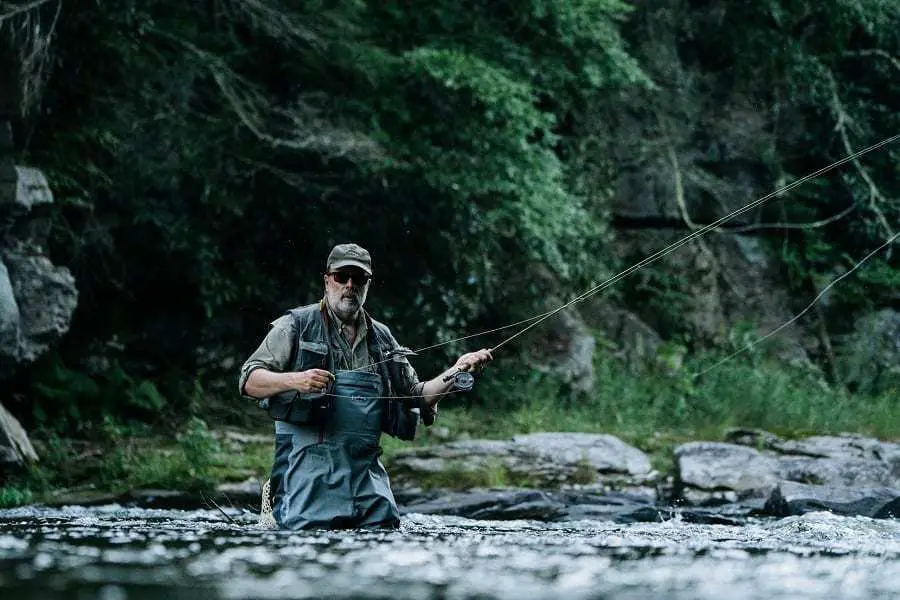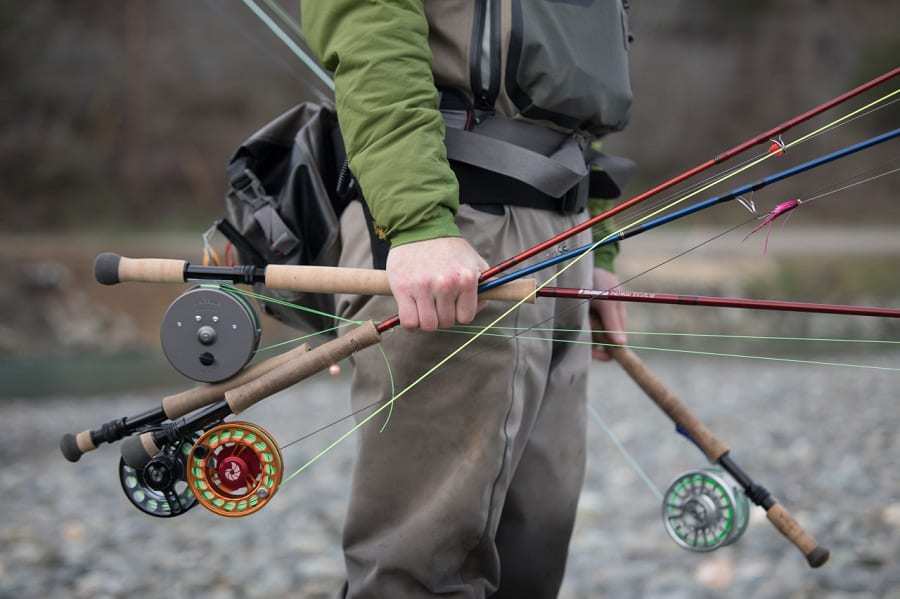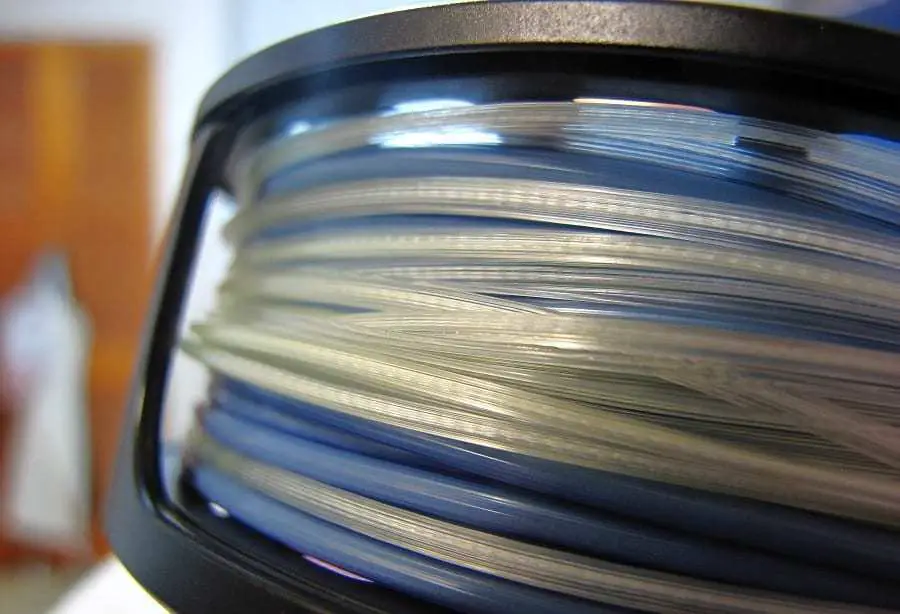Big streamers and wet flies in the current can be tremendously effective for large trout, salmon, bass, and steelhead. But first, you need to get your fly down to the depth where the fish are feeding.
Similar to the methods and fishing lines used for dry fly fishing, there are a number of ways to get your fly to sub-surface feeding fish and lines specifically tailored for streamer-fishing.
But which type of sink tip fly line will perform the best for your needs? To answer that question, we bring you our take on the best sinking tip fly lines.
Which type of sinking-tip fly line will perform best depends on your preferences and how you intend to fish. We offer our top choices and explore their strengths and weaknesses.
Check Out Our Top Pick
SF Hi-Viz Fly Fishing Line
- High quality fly fishing sink tip line made of PVC coating braided...
- Welded loops at each end, it's more convenient, easy to knots and tied...
- Comes with spool which is convenient to get onto your reel without any...
Why is it better?
- Ease of rigging
- Easy to perform long casts
- No forward dumping
Best Sinking Tip Fly Lines
With that in mind, let’s now take a closer look at our top picks.




Let’s dive into the specifics and review each line individually. You can use the list below to jump and review specific models, or you can read along and go through all the information.
Best Overall: SF Hi-Viz Fly Fishing Line
- High quality fly fishing sink tip line made of PVC coating braided...
- Welded loops at each end, it's more convenient, easy to knots and tied...
- Comes with spool which is convenient to get onto your reel without any...
The SF Hi-Viz Fly Fishing line is the favorite of many experienced anglers due to its unique construction.
Each weight line provides you with an eleven-foot-long sinking tip that is attached to a thicker portion of the line.
This innovation goes a long way to eliminate the kickback that most anglers have to put up with when they cast a sink tip li
You will get a much smoother, natural cast, without the forward-dumping, which is another common problem when working with a sink tip line.
Another innovation that puts the SF Hi-Viz line at the top of our list is the addition of a welded loop at the front end of the line.
This ensures ease of rigging. The portion of the line that floats on the water is extremely supple.
This is great news for all anglers, but especially those who are fishing on rivers, as it allows them to easily control the line.
Because the SF Hi-Viz is a weight-forward line, it makes it easier to perform long casts.
You’ll also have the ability to land the line exactly where you want it in the water, even when the wind is blowing.
JSHANMEI Sinking Top Floating Line
- High quality fly fishing sinking tip line made of PVC coating braided...
- Welded loops at each end, it's more easily to knots and tied nail...
- Comes with spool which is convenient to get onto your reel without any...
The JSHANMEI line is a 100-foot line that provides you with 15 feet of sinking line and 85 feet of floating.
Just like the SF Hi-Viz line, the floating portion of the line moves easily, allowing you to easily manipulate the line and keep up with the fish you’re chasing.
It provides you with two welded loops at the front end of the line to make it easier to rig your rod.
The line is dual-colored in green and black. The sink rate of this line is 3 inches per second, which puts it at a moderate rate of sink.
The line also has a PVC-coated, braided core along with a density-coated tip to provide greater control of the fly.
Bozeman FlyWorks Sinking Tip Fly Line
- All lines come packaged in a fly box! (vary by fly line weight)
- Sinking tip to get your flies deep in the hole quickly
- Proven weight-forward taper to load your rod
Bozeman Flyworks is a camouflage line that makes it very difficult for the fish to spot it underwater.
The sinking tip of this line extends your reach deeper into the water, allowing you to extend past the shallows for a bigger catch.
Your purchase of the Bozeman Flyworks comes with a complimentary fly box.
This is an affordable and quality sinking fly line that matches up to the quality of the more expensive, bigger brands.
The floating portion of this line is delicate enough to allow you to make sure that the hook is exactly where it needs to be.
Unlike our top two lines, this one does not come with welded loops to help with rigging.
The sink rate of this line is 4-5 inches per second. The sinking portion of the line is also shorter than those lines, at about 5 feet.
Don’t be put off by the low price; the Bozeman Flyworks line is a high-quality offering!
Maxcatch Sinking Tip Fly Line
- Maxcatch Sinking Tip Line - Ideal for streamers and wet lures for...
- 15 feet Sinking tip with the rest 85 feet floating. 3-4 ips sinking...
- 15 feet sinking tip send the lures through the water to the right...
This line is specially designed for sub-surface fishing, allowing you to get that line down really deep.
The weighted tip design makes casting an easier, more natural casting motion. You get an impressively fast sink rate of 6 inches per second with this line.
The line is 100 feet long. The first 15 feet are the sinking section, whereas the other 85 feet are the floating line.
Similar to the other lines on our list, the floating portion is supple enough and easily controlled.
The frequency sinking tip is ideal if you are going after fish such as salmon or trout in fast-moving waters.
The density-compensated tip helps drive the fly down deep to where the fish are biting.
It’s constructed from a PVC-coated, braided core. The line has a black tip with a royal blue body and running line.
This super slick intermediate running line helps you perfect those long shooting casts. It provides you with a quick load and a more natural casting motion.
There are no welded loops on it.
FAQs
HOW DO YOU USE A SINKING FLY LINE?

Most sinking fly lines are 90-foot-long. The first 10 to 30 feet is the sinking section of the line, depending on the speed and depth of sinking that is required.
The rest of the fly line is a floating line. The floating part of the line has tiny micro balloons inserted onto the line. These are designed to enable this part of the fly line to float.
This floating portion is very important as it allows you to control the line more accurately. It also helps you to cast the line easily.
A sinking fly line is designed to be used just like a conventional fly line. It makes use of the previously mentioned innovations, making it easier to cast and control.
Look for a sinking fly line that’s weighted evenly. You need to get the front taper of the line down to where the fish can see it and move it around naturally as an insect would do.
A sinking fly line is used to fish for streamers and nymphs. These fish catch the majority of their food well below the surface of the water, so the sinking fly line is ideal to entice them to bite.
The part of the fly line that sinks is coated with powdered tungsten. This heaviness causes the line to sink.
Fly lines vary in the amount of tungsten that has been added. This provides you with a range of sink rates. Lead used to be used for sinking fly lines but has been replaced with the more environmentally friendly tungsten.
WHAT IS THE SINKING FLY LINE USED FOR?
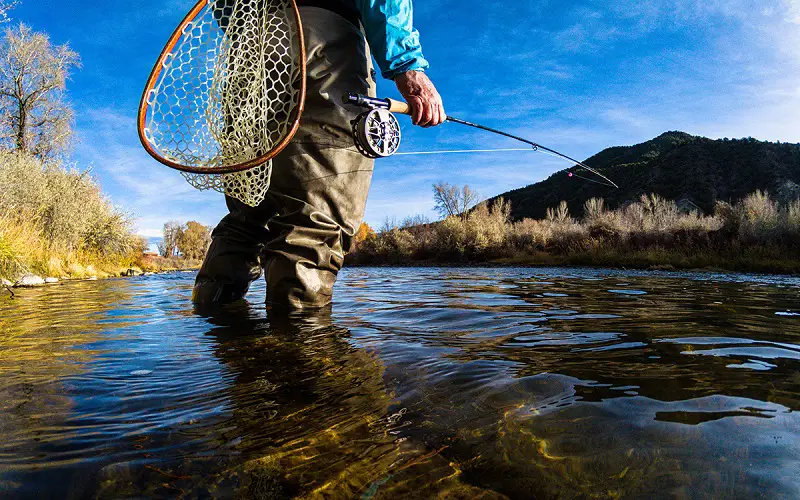
While a full sink fly line is ideal for fishing in still water, a sink tip fly line is more suitable for moving water, e.g stream fishing or nymph fishing.
In these cases, the fish catch the majority of their food well below the surface, so the sinking fly line is perfect for enticing them to bite.
If you’re a wader, a sink line will help you remain in your wading zone longer than the other types of lines will, which will increase the success of your fishing session.
Also, due to its ability to sink where the fish are, it’ll also be more helpful when you’re drift-fishing.
If you’ve ever tried fishing in moving water with a floating line, you’re probably aware that the effort is unrewarding even with the help of split shots. But with a sink fly line, it’ll be much easier, and you won’t have to doubt your fly rod.
The part of the fly line that sinks is coated with powdered tungsten, making it heavier and causing the line to sink.
Fly lines vary in the amount of tungsten that has been added, providing you with a range that covers different sink rates.
HOW DO I KNOW IF MY FLY LINE IS FLOATING OR SINKING?
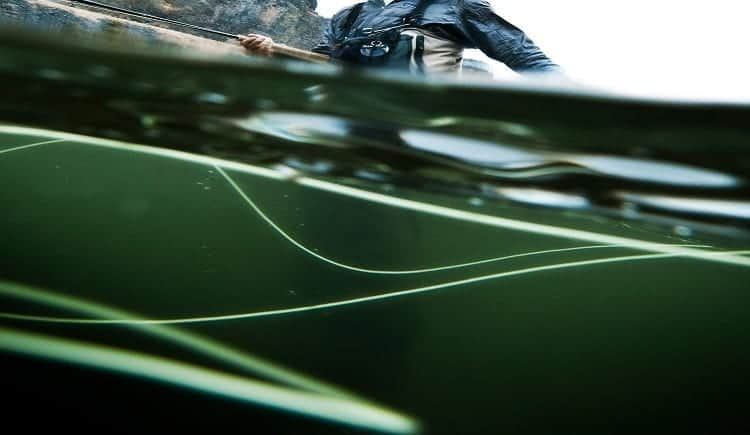
The easiest way to check if the fly line is a floating or a sinking one is to read what’s on the package. The label will almost always tell you the type of the line.
You might also find lines that are labeled as weight-forward taper (W/F). This type of line will be tapered over the first thirty feet, making this portion of the line heavier than the rest. This is the opposite of a sinking fly line.
If you’ve already unpacked your fly line, you can tell by looking at it whether it is a floating or a sinking line. Sinking lines will have mini balloons positioned along the first portion of the line.
This keeps this portion of the line above the surface of the water and will be easy to see. The final ten to thirty feet of a sinking line will be coated with tungsten which will also be clearly visible to the naked eye.
Why Choose A Sinking Tip?
Before you select a sinking tip fly line you need to know why the characteristics of a sink tip are advantageous in moving water.
Like full-sinking lines, sinking tip fly lines are made to sink at a specific rate, measured in inches per second (in/s).
While casting, the slack from the line won’t sink around your feet, tangle in the rocks, and get hung up on the river bottom as a full sink line would.
That’s because the main running line on the sinking tip line is actually a floating line, and only the tip will sink. It allows you to get your fly down while avoiding the tangled mishaps that easily occur in the shallows.
Obviously, you don’t want to fish a fast sink tip line in water that is too shallow, because you’ll snag the bottom. With that in mind, the most important consideration is at what depth you expect to find the fish feeding.
Casting a fast sink tip in relatively shallow water will require a faster retrieve. But if a fast retrieve is what draws strikes, then a fast sinking line might be exactly what you need.
That will also likely be the case if you need your fly to be recast quickly due to a fast-moving current.
If you find that the fish are prone to take during a slow retrieve, or even during pauses in your retrieve, then you will need a slow sink tip line to avoid losing all your flies on the bottom.
To increase your chances, it’s important that you select a fly line suited for the water you intend to fish. Some of that comes with experience and knowing the water you are fishing, and for the rest of it, you can explore our content.
References:


